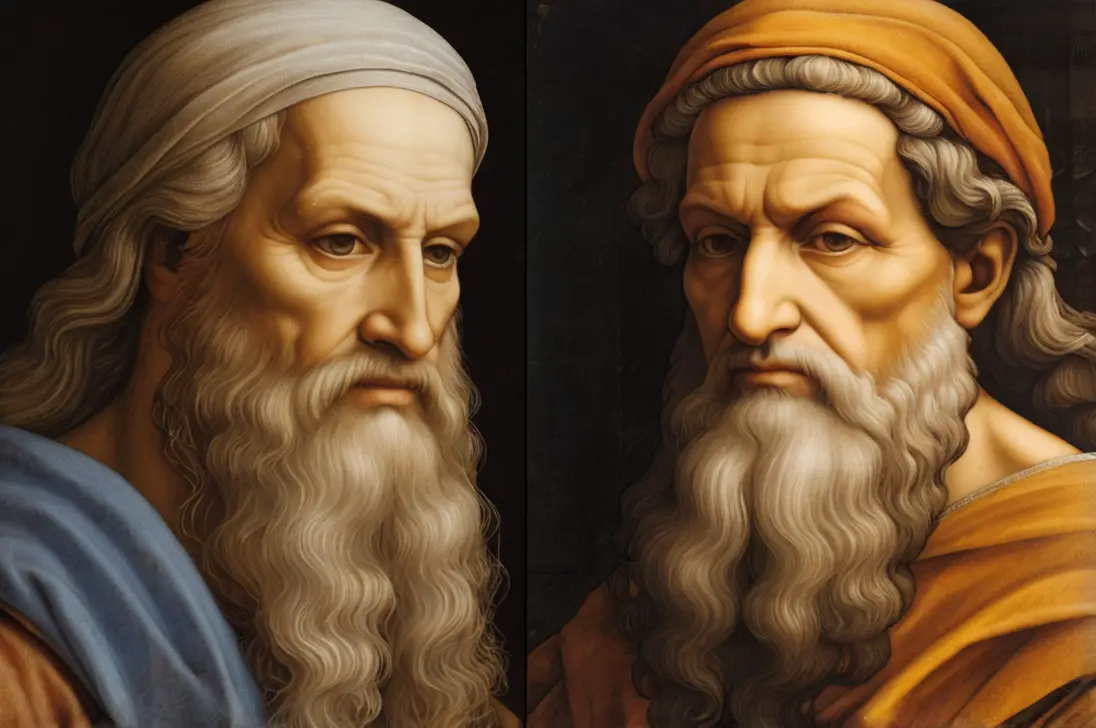
The names Leonardo da Vinci and Michelangelo are synonymous with artistic excellence.
Both masters left an indelible mark on the world of art, science, and architecture.
While they shared some similarities, their unique styles, contributions, and personalities set them apart.
In this article, we will delve into the lives and works of these two Renaissance giants, highlighting their key differences and the reasons why they continue to captivate audiences to this day.
Leonardo da Vinci

Background
Leonardo da Vinci, born on April 15, 1452, in Vinci, Italy, was a remarkable figure of the Renaissance period.
He was the illegitimate son of a notary (a legal official) and a peasant woman.
From a young age, Leonardo showed immense curiosity and a deep passion for learning.
He grew up in Vinci and later moved to Florence, a bustling center of art and culture during that time.
- Read also: Masterpieces Unveiled: Exploring Italian Renaissance Sculptures
- Read also: Contrasting Worlds: Renaissance Art Vs. Medieval Art
Artistic style
Leonardo da Vinci’s artistic style is renowned for its unique qualities:
- Sfumato technique: He perfected the use of sfumato, a method where he applied thin layers of paint to create a soft, hazy effect.
- Attention to detail: Leonardo was known for his meticulous attention to detail, especially in portraying human emotions and expressions. His artworks, such as the Mona Lisa and The Last Supper, are celebrated for their depth and realism.
Legacy
Leonardo da Vinci’s impact extends far beyond his artistic achievements:
- Renaissance man: He embodied the ideal of the “Renaissance man,” excelling not only in art but also in various other fields.
- Engineering and inventions: Leonardo’s notebooks are filled with designs and inventions that were far ahead of his time, ranging from flying machines and armored vehicles to intricate canal systems and city plans.
- Scientific contributions: He conducted groundbreaking studies in anatomy, dissecting human bodies to understand their structure and function.
- Mathematics and philosophy: Leonardo also made contributions to mathematics and philosophy, exploring concepts like perspective and the nature of light.
Michelangelo

Background
Michelangelo Buonarroti, born on March 6, 1475, in Caprese, Italy, was one of the greatest artists of the Renaissance.
He was the second of five sons born to a magistrate (a legal official) and a homemaker.
From a young age, Michelangelo showed a deep spiritual devotion and a strong desire to create art that would honor and glorify God.
Artistic Style
Michelangelo’s artistic style is distinguished by several key elements:
- Non-finito technique: He pioneered the use of non-finito, where sculptures are intentionally left rough and unfinished in some parts.
- Marble carving mastery: Michelangelo was renowned for his skill in sculpting marble, transforming the hard stone into lifelike and expressive forms.
- Human form: He had an unparalleled ability to depict the human body with accuracy and dynamism, capturing both its physical beauty and emotional intensity.
Michelangelo’s most famous works include the awe-inspiring ceiling frescoes of the Sistine Chapel and his monumental statue of David, which exemplify his mastery of form and his deep understanding of human anatomy and expression.
Legacy
Michelangelo’s legacy is profound and enduring:
- Artistic mastery: He is celebrated as a master of his craft, influencing countless artists across generations with his innovative techniques and profound artistic vision.
- Inspiration: His works continue to captivate and inspire audiences worldwide, drawing admiration for their technical brilliance and emotional depth.
- Beyond art: Michelangelo’s influence extends beyond the realm of art into literature, philosophy, and culture.
Key Differences between Da Vinci and Michelangelo
While both artists were masters of their craft, there are several key differences between them:
| Feature | Leonardo da Vinci |
Michelangelo Buonarroti
|
| Birth | April 15, 1452, Vinci, Italy |
March 6, 1475, Caprese, Italy
|
| Background | Illegitimate son of a notary and a peasant woman |
Second of five sons of a magistrate and a homemaker
|
| Artistic Fields | Painting, sculpture, engineering |
Sculpture, painting, architecture
|
| Artistic Style | Sfumato technique (soft, hazy effect); meticulous detail |
Non-finito technique (rough, unfinished areas); mastery in marble carving
|
| Notable Works | Mona Lisa, The Last Supper |
Sistine Chapel ceiling, David
|
| Scientific Contributions | Studies in anatomy, engineering designs |
Focus on art; less involvement in scientific pursuits
|
| Personal Characteristics | Curious, multi-talented, visionary |
Spiritual, intense, perfectionist
|
| Legacy | Renaissance polymath; influence in art, science, and engineering |
Master sculptor; profound impact on Renaissance and Baroque art
|
| Famous Quote | Simplicity is the ultimate sophistication. |
I saw the angel in the marble and carved until I set him free.
|
- Read also: Renaissance Invention Timeline: Innovations That Transformed History
- Read also: Renaissance Religion Facts: How Religion Ignited a New Era
Conclusion
Leonardo da Vinci and Michelangelo were two of the most talented and influential artists of the Renaissance.
While they shared some similarities, their unique styles, contributions, and personalities set them apart.
Da Vinci’s incredible attention to detail and his use of sfumato created works that continue to captivate audiences to this day.
Michelangelo’s incredible skill in carving marble and his use of non-finito created works that are both beautiful and powerful.
Both artists left an indelible mark on the world of art, and their legacy continues to inspire and influence artists, scientists, and engineers to this day.



